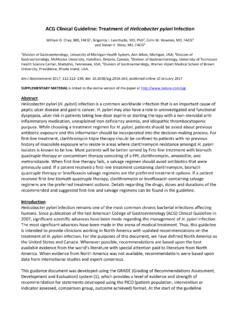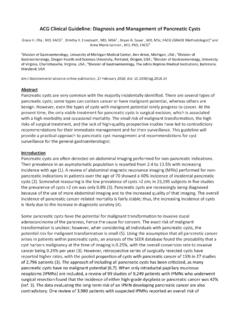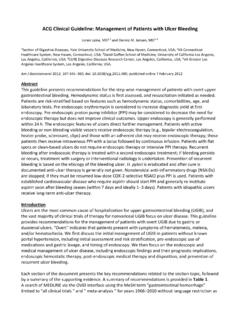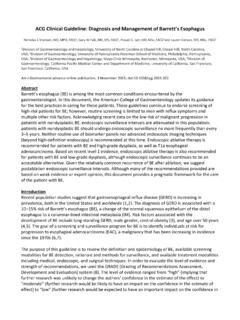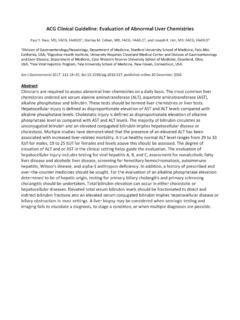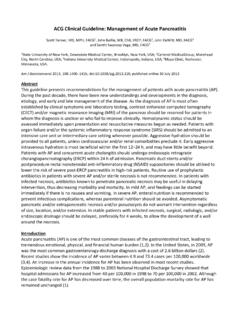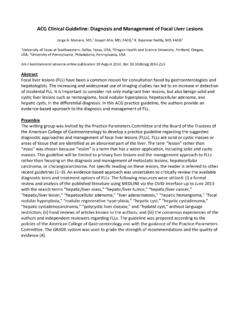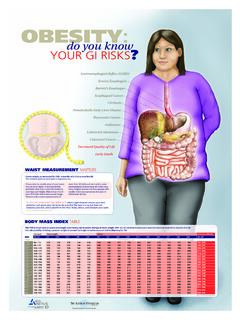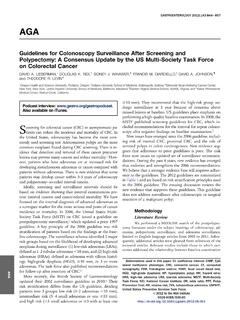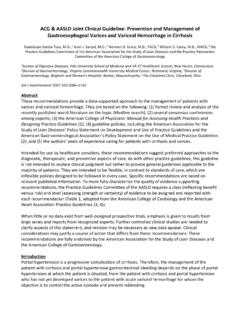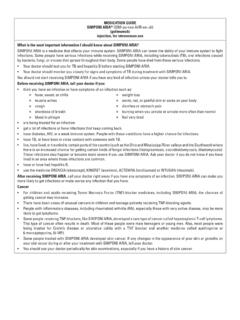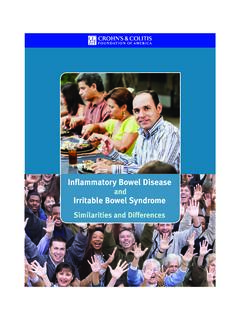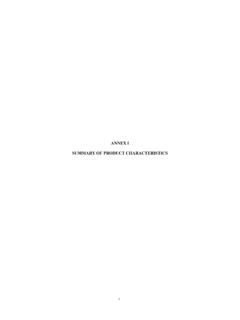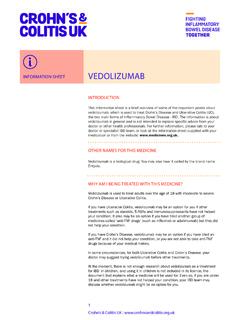Transcription of ACG Clinical Guideline: Management of Crohn’s Disease in ...
1 ACG Clinical Guideline: Management of Crohn's Disease in Adults Gary R. Lichtenstein, MD, FACG1, Edward V. Loftus Jr., MD, FACG2, Kim L. Isaacs, MD, PhD, FACG3, Miguel D. Regueiro, MD, FACG4, Lauren B. Gerson , MD, MSc, MACG (GRADE Methodologist)5, and Bruce E. Sands , MD, MS, FACG6. 1. Department of Medicine, Division of Gastroenterology, Hospital of the University of Pennsylvania, Perelman School of Medicine of the University of Pennsylvania, Philadelphia, Pennsylvania, USA; 2 Division of Gastroenterology and Hepatology, Mayo Clinic, Rochester, Minnesota, USA; 3 Department of Medicine, Division of Gastroenterology, University of North Carolina Chapel Hill, Chapel Hill, North Carolina, USA; 4 Department of Gastroenterology and Hepatology, Cleveland Clinic, Cleveland, Ohio, USA; 5 Department of Medicine, Division of Gastroenterology, California Pacific Medical Center, San Francisco, California, USA; 6Dr Henry D.
2 Janowitz Division of Gastroenterology, Icahn School of Medicine at Mount Sinai, New York, New York, USA; Deceased. Am J Gastroenterol advance online publication, 27 March 2018; doi: Abstract Crohn's Disease is an idiopathic inflammatory disorder of unknown etiology with genetic, immunologic, and environmental influences. The incidence of Crohn's Disease has steadily increased over the past several decades. The diagnosis and treatment of patients with Crohn's Disease has evolved since the last practice guideline was published. These guidelines represent the official practice recommendations of the American College of Gastroenterology and were developed under the auspices of the Practice Parameters Committee for the Management of adult patients with Crohn's Disease .
3 These guidelines are established for Clinical practice with the intent of suggesting preferable approaches to particular medical problems as established by interpretation and collation of scientifically valid research, derived from extensive review of published literature. When exercising Clinical judgment, health-care providers should incorporate this guideline along with patient's needs, desires, and their values in order to fully and appropriately care for patients with Crohn's Disease . This guideline is intended to be flexible, not necessarily indicating the only acceptable approach, and should be distinguished from standards of care that are inflexible and rarely violated. To evaluate the level of evidence and strength of recommendations, we used the Grading of Recommendations Assessment, Development, and Evaluation (GRADE) system.
4 The Committee reviews guidelines in depth, with participation from experienced clinicians and others in related fields. The final recommendations are based on the data available at the time of the production of the document and may be updated with pertinent scientific developments at a later time. Introduction Crohn's Disease has been increasing in incidence and prevalence worldwide. At the same time, the number of therapeutic options is rapidly increasing. The purpose of this guideline is to review Crohn's Disease Clinical features and natural history, diagnostics, and therapeutic interventions. To prepare this guideline, literature searches on the different areas were conducted using Ovid MEDLINE from 1946 to 2018, EMBASE from 1988 to 2018, and SCOPUS from 1980 to 2018.
5 The major terms that were searched were Crohn's Disease , inflammatory bowel diseases (IBD), regional ileitis, and regional enteritis. These were translated into EMTREE controlled vocabulary as enteritis and Crohn's Disease . The remainder of the search included key words related to the subject area that included Clinical features, natural history, diagnosis, biomarkers, treatment, and therapy. For each of the therapeutic sections, key words included the individual drug names. The results used for analysis were limited to primary Clinical trials, meta-analyses, systematic reviews, and prior guidelines. Where there were limited data, abstracts were used. In many areas reviewed, there were not available Clinical trial data, and these areas are discussed as summary statements rather than GRADE statements.
6 To evaluate the level of evidence and strength of recommendations, we used the Grading of Recommendations Assessment, Development, and Evaluation (GRADE) system (1). The level of evidence could range from high (implying that further research as unlikely to change the authors'. confidence in the estimate of the effect), moderate (further research would be likely to have an impact on the confidence in the estimate of effect), low (further research would be expected to have an important impact on the confidence in the estimate of the effect and would be likely to change the estimate), or very low (any estimate of effect is very uncertain). The strength of a recommendation was graded as strong when the desirable effects of an intervention clearly outweigh the undesirable effects and as conditional when there is uncertainty about the trade-off s.
7 We preferentially used metaanalyses or systematic reviews when available, followed by Clinical trials and retrospective cohort studies. To determine the level of evidence, we entered data for the papers of highest evidence into the GRADE program (accessible at ). The GRADE recommendations statements from this guideline are in Table 1. Summary statements are descriptive and do not have associated evidence-based ratings (Table 2). In this guideline, the numbered statements are the GRADE. statements and the unnumbered statements relate to summary statements. Table 1. Summary and strength of recommendations Diagnosis Routine laboratory investigation 1. Fecal calprotectin is a helpful test that should be considered to help differentiate the presence of IBD from irritable bowel syndrome (IBS) (strong recommendation, moderate level of evidence).
8 Endoscopy 2. In patients at particularly high risk for colorectal neoplasia ( , personal history of dysplasia, primary sclerosing cholangitis), chromoendoscopy should be used during colonoscopy, as it may increase the diagnostic yield for detection of colorectal dysplasia, especially compared with standard-definition white light endoscopy (conditional recommendation, low level of evidence). 3. For patients undergoing surveillance colonoscopy there is insufficient evidence to recommend universal chromoendoscopy for IBD colorectal neoplasia surveillance if the endoscopist has access to high-definition white light endoscopy (conditional recommendation, moderate level of evidence). 4. Narrow-band imaging should not be used during colorectal neoplasia surveillance examinations for Crohn's Disease (conditional recommendation, very low level of evidence).
9 5. Endoscopists who are sufficiently trained and comfortable performing chromoendoscopy may be able to forgo obtaining random surveillance biopsies and rely on targeted biopsies alone (conditional recommendation, very low level of evidence). Disease modifiers 6. Nonsteroidal anti-inflammatory drugs (NSAIDs) may exacerbate Disease activity and should be avoided when possible in patients with Crohn's Disease (strong recommendation, low level of evidence). Table 1. Summary and strength of recommendations continued 7. Cigarette smoking exacerbates Disease activity and accelerates Disease recurrence and should be avoided. Active smoking cessation programs should be encouraged (strong recommendation, low level of evidence). 8. Usage of antibiotics should not be restricted in Crohn's Disease patients in order to prevent Disease flares (conditional recommendation, very low level of evidence).
10 9. Perceived stress, depression, and anxiety, which are common in IBD, are factors that lead to decreased health-related quality of life in patients with Crohn's Disease , and lead to lower adherence to provider recommendations. Assessment and Management of stress, depression, and anxiety should be included as part of the comprehensive care of the Crohn's Disease patient (strong recommendation, very low level of evidence). Medical Therapy Mild-to-moderately severe Disease /low-risk Disease 10. Sulfasalazine is effective for treating symptoms of colonic Crohn's Disease that is mild to moderately active and can be used as treatment for this patient population (conditional recommendation, low level of evidence). 11. Oral mesalamine has not consistently been demonstrated to be effective compared with placebo for induction of remission and achieving mucosal healing in patients with active Crohn's Disease and should not be used to treat patients with active Crohn's Disease (strong recommendation, moderate level of evidence).
